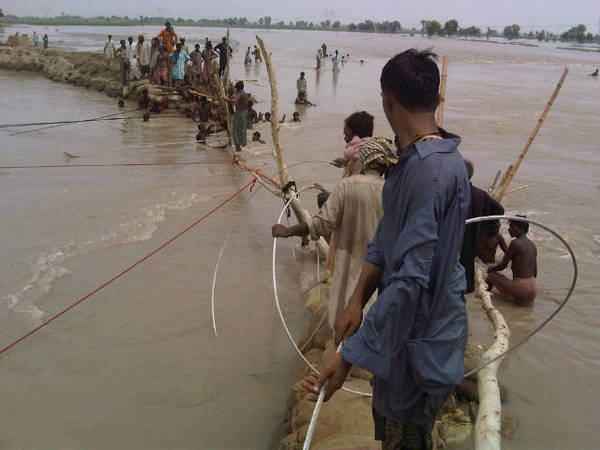Ever since the Pakistan floods started to get worse, I had been thinking of doing some meaningful relief activities, and so far my work had been confined to helping the flood victims stationed in a nearby school in Multan. I also had some money collected from friends and family and intended to embark upon a trip to the flood affected regions.
I, along with some students of Pakistani universities had founded Azm-e-Nau – Let Us Rebuild Pakistan, to involve the youth in social welfare activities. So this was our big opportunity and we collaborated with members of Pakistan Youth and Children Forum (PCYF), a Multan-based local non-profit organization for our relief trips.
We started our first field trip on August 15, 2010 when we took a mini-truck load of food and relief materials to Muzaffargarh and Mehmood Kot, which are the least developed regions of Punjab. We could only buy relief goods amounting to 50,000 rupees (US$ 585), a meager but precious first attempt.
I shared in my blog how the trip materialized for me:
Today, as I received an sms from a friend inviting me to a trip to Muzaffargarh to disburse relief good, I promptly replied in affirmative (a huge part in this readiness was played by the inspiring narrations from others). By 11 a.m. I was heading straight for Ghanta Ghar where a number of PCYF (Pakistan Children and Youth Foundation, a local non-profit organization) members awaited departure. After brief introductions, we embarked upon the journey.
Flood Relief Trip Part 1: uploaded by LetusrebuildPaksitan
What struck me most was the utter lack of any governmental authority, any official relief work or any other sort of aid that could have come from more organized quarters in this region. Even army's relief role in the region was confined to a tiny camp near Muzaffargarh power station where it comprised a very bare fraction of the entire mass. Having read so much about relief camps and activities, it was rather shocking for me that this region seemed utterly neglected.
Flood Relief Trip Part 2: uploaded by LetusrebuildPaksitan
Helping the relief victims brought into urban relief camps is more organized and convenient. But those that are still in the flood-ravaged regions or nearby are the ones in severest need of relief goods. Many of them are carrying farm animals with them and hence, take to camping rather than traveling to safer places. Those who choose to leave are forced to sell their animals at a fraction of their original price.
Read the rest here.
The flood victims told me terrifying tales which are detailed in another post in my blog:
“We barely fled with our lives. 7-feet waves washed across the entire village when the Muzaffargarh Canal overflowed” narrates Muhammad Hanif of Basti Kandi Wala, a village at a few kilometers from Mehmood Kot. Standing near a crowd of displaced populace, Hanif tells that there is no chance for a normal life, not at least for a long time, “As long as waters recede completely, there's no going back. And even when it does, we'll have homes to build, marshy lands to deal with and above all, the rent that is to be paid to the landlords.”
The area had been cut off both ways for about a week when the road drowned under-water. At one side, Mehmood Kot and at the other, Kot Addu was inaccessible. [..] “For a week, we were stranded, with no food or relief from the authorities or anyone.” Ghulam Asghar, aged 35 relates.
After coming back from Muzaffargarh and Mehmood Kot, I was able to make arrangements for medical camps using my connections at the Nishtar Medical Hospital which is among the largest hospitals in Pakistan, and get doctors from there.
I wrote in details about the Medical Relief Camps organized by by Azm-e-Nau here:
After a week-long effort, Azm-e-Nau had been able to procure a fair amount of medicine provisions, four doctors from Nishtar and a dispenser. Initially the plan was to pitch up a tent at an appropriate location and then stay there for the rest of the day. However, considering a lot of scattered clusters of tents and people, we decided to go mobile. Three stops at different localities, including Qureshi wala, were made and some 350 – 400 patients were diagnosed and treated with basic medicines. [..] Throughout the check-up, a log of the diagnosis was continuously maintained. This, we did to keep track of the more prevalent diseases and make our arrangements accordingly for future trips.
Some times, it requires a real experience to truly feel the magnanimity of a situation. Watching the plight of the flood victims on TV may arouse a distant sympathy, but when I saw them face to face, watched the naked hunger written in their parched faces and witnessed fights over food and water, I realized how huge the problem was and how badly these people needed help. This only persuaded me to plan another medical relief trip to the region, this time into the remote regions of Rajanpur and Jampur. The visit will be a three-day trip, scheduled from August 27- August 29.









2 comments
The spirit of volunteerism within Pakistan is overwhelming.After working long hours, volunteers are contributing their time and resources.I strongly believe that this spirit of volunteerism will take this country further…